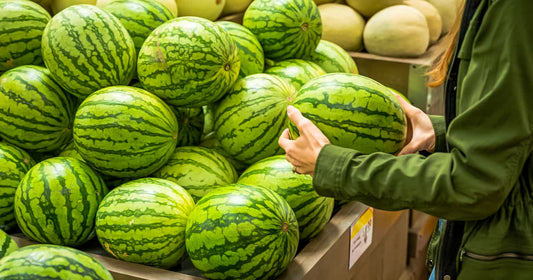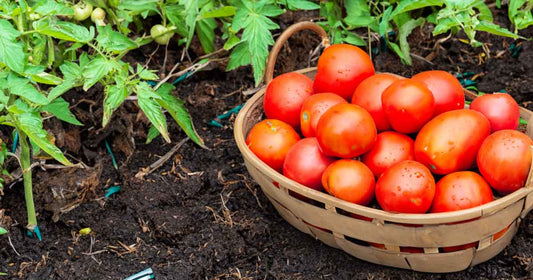
Best Soil Types for Tomato Cultivation in Different U.S. Climates
Share
The Best Soil Types for Tomatoes By Region
Growing tomatoes successfully requires selecting the right soil type, especially considering the diverse climates across the United States. Each region presents unique challenges and opportunities for tomato cultivation. This guide will help you choose the best soil types for tomato plants in various U.S. climates, ensuring healthy growth and bountiful harvests.
Quick Tip: Soil Requirements for Planting Tomatoes
According to University of New Hampshire's Fact Sheet For Growing Tomatoes, Tomato plants will grow well in well-drained sites that receive full sun for most of the day. The soil pH should be slightly acidic (6.2 to 6.8). Excess nitrogen can result in plants with lush, vigorous foliage but little fruit production. Although it is best to determine lime and fertilizer needs from the results of a soil test, a rule of thumb for gardeners lacking test data is to apply 2½ pounds of a complete fertilizer such as 10-10-10 (or the equivalent) per 100 square feet of garden area. Work the fertilizer into the soil about 2 weeks before planting.
Northeast Region: Recommended Soil For Growing Tomatoes
Climate: Cool summers, cold winters, moderate rainfall
Best Soil Types:
- Loamy Soil: Rich, well-draining loam with a good balance of sand, silt, and clay is ideal. Loamy soil retains moisture without becoming waterlogged and provides essential nutrients.
- Amended Garden Soil: Improve garden soil by adding organic compost to enhance fertility and drainage. This is particularly beneficial in the Northeast, where the growing season is shorter.
- Peat-Based Mix: Adding peat moss helps retain moisture and improves soil structure, crucial for the cooler climate.
Suggested Soil Amendments:
- Compost: Improves fertility and soil structure.
- Peat Moss: Enhances moisture retention and soil aeration.
- Perlite: Improves drainage and prevents compaction.
- Lime: Raises pH level if the soil is too acidic.
Southeast Region: Recommended Soil For Growing Tomatoes
Climate: Hot, humid summers, mild winters, high rainfall
Best Soil Types:
- Sandy Loam Soil: This soil type offers excellent drainage, which is crucial in the humid climate to prevent root rot. Enrich sandy loam with organic matter to boost moisture retention and nutrient content.
- Raised Bed Soil: Raised beds with a mix of garden soil, compost, and peat moss can improve drainage and prevent waterlogging during heavy rains.
- Pine Bark Fines: Incorporating pine bark fines can enhance aeration and drainage while maintaining necessary moisture.
Suggested Soil Amendments:
- Compost: Increases organic matter and nutrient content.
- Peat Moss: Improves moisture retention.
- Pine Bark Fines: Enhances aeration and drainage.
- Gypsum: Helps improve soil structure and reduces compaction.
Midwest Region: Recommended Soil For Growing Tomatoes
Climate: Hot summers, cold winters, moderate rainfall
Best Soil Types:
- Clay Loam Soil: Common in the Midwest, clay loam retains nutrients well but can be heavy and compact. Amend it with compost and peat moss to improve aeration and drainage.
- Mulched Soil: Applying mulch around tomato plants helps regulate soil temperature and moisture, protecting roots from extreme weather variations.
- Perlite Mix: Mixing perlite into the soil can improve drainage and prevent compaction, which is crucial for heavy clay soils.
Suggested Soil Amendments:
- Compost: Adds organic matter and improves soil fertility.
- Peat Moss: Enhances soil aeration and moisture retention.
- Perlite: Improves drainage and prevents soil compaction.
- Gypsum: Helps break up heavy clay soils.
Southwest Region: Recommended Soil For Growing Tomatoes
Climate: Hot, dry summers, mild winters, low rainfall
Best Soil Types:
- Sandy Soil: Sandy soil drains quickly, which is beneficial in arid conditions. However, it needs to be enriched with compost and organic matter to improve water retention and nutrient availability.
- Drip Irrigation Systems: Combine sandy soil with drip irrigation to maintain consistent moisture levels, essential for tomato growth in the Southwest’s dry climate.
- Coconut Coir: Adding coconut coir can significantly enhance moisture retention without compromising drainage.
Suggested Soil Amendments:
- Compost: Enriches the soil with organic matter and nutrients.
- Coconut Coir: Improves water retention.
- Perlite: Enhances soil aeration and drainage.
- Worm Castings: Boosts soil fertility and microbial activity.
Pacific Northwest Region: Recommended Soil For Growing Tomatoes
Climate: Mild summers, wet winters, high rainfall
Best Soil Types:
- Loamy Soil: Loamy soil is ideal for this region due to its balanced texture and good drainage. Adding compost can further enhance its fertility and structure.
- Raised Bed Soil: Using raised beds helps manage excessive moisture from frequent rains, preventing root diseases and promoting healthy growth.
- Compost-Enriched Soil: Regularly incorporating compost improves soil structure and nutrient content, which is beneficial given the high rainfall.
Suggested Soil Amendments:
- Compost: Increases organic content and improves soil structure.
- Perlite: Enhances drainage and aeration.
- Peat Moss: Improves moisture retention.
- Lime: Adjusts soil pH if necessary.
Southern California: Recommended Soil For Growing Tomatoes
Climate: Mild, dry summers, wet winters, low to moderate rainfall
Best Soil Types:
- Sandy Loam Soil: This soil type provides excellent drainage, which is crucial in Southern California’s dry summers. Enhance it with organic matter to improve its water-holding capacity.
- Hydroponic Systems: For areas with limited water resources, hydroponic systems using coconut coir or perlite as a growing medium can be very effective, offering precise control over water and nutrient delivery.
- Decomposed Granite: Incorporating decomposed granite can improve drainage and aeration in sandy soils.
Suggested Soil Amendments:
- Compost: Enriches the soil with essential nutrients and organic matter.
- Coconut Coir: Enhances water retention in sandy soils.
- Perlite: Improves drainage and aeration.
- Gypsum: Helps improve soil structure and water penetration.
General Tips for All Regions When Planting Tomatoes
- Organic Matter: Regardless of your region, incorporating organic matter such as compost, aged manure, or leaf mold into the soil improves its structure, fertility, and water-holding capacity.
- pH Level: Ensure the soil pH is between 6.0 and 6.8 for optimal nutrient availability to tomato plants.
- Soil Testing: Conduct regular soil tests to monitor nutrient levels and pH, adjusting as needed with appropriate amendments.
By selecting the right soil type and incorporating suitable soil amendments tailored to the specific climate and soil conditions of your region, you can significantly enhance the health and productivity of your tomato plants. For high-quality gardening soil and other garden supplies, visit us in-store or shop online at Perris Hydroponics.




